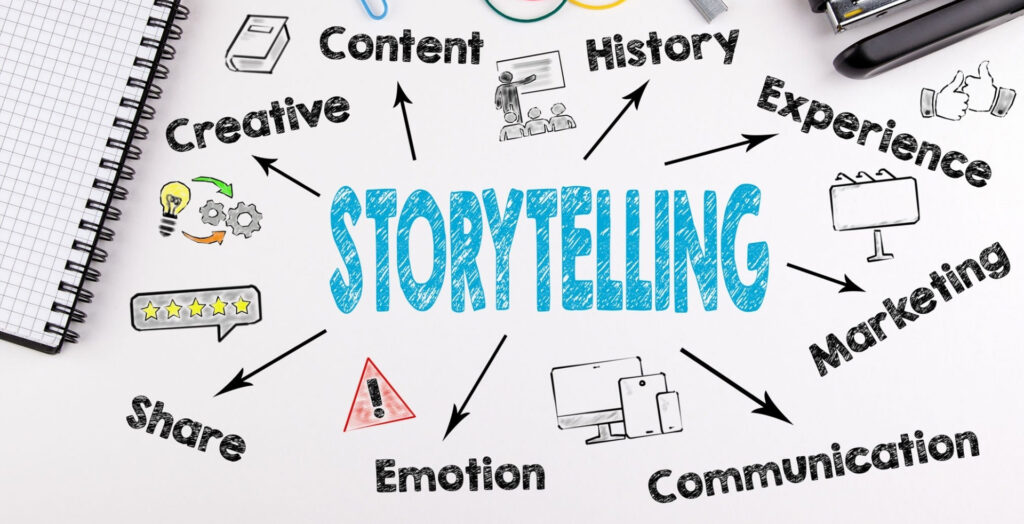The Art of Storytelling in Marketing: Crafting a Narrative that Resonates

Introduction
In the fast-paced world of modern marketing, capturing the attention and engaging the emotions of your target audience is a challenging endeavor. Amidst the relentless flow of information, stories have emerged as a powerful tool to cut through the noise and create meaningful connections. The art of storytelling in marketing goes beyond mere product promotion; it involves crafting a narrative that resonates with your audience on a profound level. In this blog post, we will explore the importance of storytelling in marketing and provide practical guidance on how to create compelling narratives that leave a lasting impact.
Chapter 1: The Power of Storytelling in Marketing
1.1 What is Storytelling in Marketing?
Storytelling in marketing is the art of using narratives to convey a brand’s message, values, and identity. It involves creating a compelling story that emotionally connects with the audience, making them more likely to engage with your brand.
1.2 Why Storytelling Matters
- Emotional Engagement: Stories tap into human emotions, creating a deeper connection with the audience.
- Memorability: People are more likely to remember a story than a list of facts or statistics.
- Differentiation: Stories set your brand apart and help you stand out in a crowded market.
- Brand Loyalty: A well-told story can foster brand loyalty by creating a sense of belonging and shared values.
Chapter 2: The Elements of a Great Brand Story
2.1 Character
Your brand story should have relatable characters, whether it’s the founder, employees, or customers. These characters drive the narrative and make it more personal.
2.2 Conflict
Conflict creates tension and interest in your story. It doesn’t have to be a dramatic conflict; it can be a challenge or obstacle your brand faced and overcame.
2.3 Resolution
The resolution is the satisfying conclusion to your story. It should demonstrate how your brand’s products or services help resolve the conflict or challenge.
2.4 Authenticity
Authenticity is crucial. Your audience can spot insincerity from a mile away. Be genuine in your storytelling to build trust.
Chapter 3: Finding Your Brand’s Story
3.1 Know Your Audience
Understanding your target audience’s values, aspirations, and pain points is essential. Tailor your story to resonate with their needs and desires.
3.2 Identify Your Unique Selling Proposition (USP)
What sets your brand apart from competitors? Your USP can be a central theme in your story, highlighting why your products or services are the best choice.
3.3 Draw Inspiration from Your Brand’s History
Your brand’s history can be a rich source of storytelling material. Share the journey of how your brand was founded and its evolution over time.
Chapter 4: Crafting a Compelling Narrative
4.1 Start with a Hook
The opening of your story should grab the audience’s attention immediately. It can be a question, a surprising fact, or a relatable anecdote.
4.2 Build Tension
Use conflict or challenges to keep the audience engaged. This tension should drive the narrative forward, making your audience eager to learn what happens next.
4.3 Create a Emotional Connection
Appeal to emotions by showcasing how your brand’s products or services positively impact people’s lives. Share relatable experiences and struggles.
4.4 Keep it Simple
Avoid overly complex narratives that can confuse or overwhelm the audience. A simple, straightforward story is often the most effective.
Chapter 5: Visual Storytelling
5.1 The Power of Visuals
Visual elements such as images, videos, and graphics can enhance your storytelling. They add depth and make the story more engaging.
5.2 Consistency in Visuals
Maintain consistency in visual storytelling to reinforce your brand identity. Use consistent colors, fonts, and imagery across all platforms.
Chapter 6: Storytelling Across Different Marketing Channels
6.1 Social Media
Craft shorter, snackable stories for social media platforms like Instagram Stories, Facebook, and Twitter. Use visuals and concise text to convey your brand’s narrative.
6.2 Blogging
Blogs provide an opportunity for more in-depth storytelling. Share longer narratives, customer stories, or behind-the-scenes content on your blog.
6.3 Email Marketing
Incorporate storytelling into your email marketing campaigns to engage subscribers and build stronger relationships.
6.4 Video Marketing
Video is a powerful medium for storytelling. Create video content that tells your brand’s story, shares customer testimonials, or highlights your mission.
Chapter 7: Measuring the Impact of Storytelling
7.1 Key Performance Indicators (KPIs)
Define KPIs that align with your storytelling goals. These may include engagement metrics, website traffic, conversion rates, and brand sentiment.
7.2 A/B Testing
Experiment with different storytelling approaches and content formats to determine what resonates best with your audience.
7.3 Qualitative Feedback
Collect feedback from customers and audience members to understand how your storytelling efforts are perceived and make adjustments accordingly.
Chapter 8: Evolving Trends in Storytelling
8.1 Interactive Content
Interactive content, such as quizzes, polls, and immersive experiences, is becoming more prevalent in storytelling.
8.2 User-Generated Content
Encourage customers to share their own stories and experiences with your brand. User-generated content can be a powerful form of storytelling.
Chapter 9: Conclusion
In the digital age, storytelling is not just a marketing strategy; it’s an art form that allows brands to connect with their audience on a deeper level. By understanding the elements of a great brand story, finding your unique narrative, and crafting compelling stories across various marketing channels, you can create a lasting impact that resonates with your audience. Remember that effective storytelling is an ongoing process of refinement and adaptation, and it’s a journey that leads to stronger brand connections and continued growth. Embrace the art of storytelling, and watch your brand thrive in the hearts and minds of your customers.